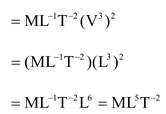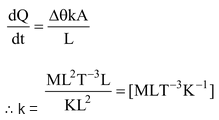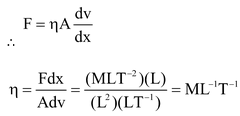
Dimensions
Units And Dimensions of Class 11
The dimension of a physical quantity are the powers to which the fundamental (or base) quantities like mass, length and time etc. have to be raised to represent the quantity. Consider the physical quantity “ Force ”. The unit of force is Newton. Read NCERT textbook and try to solve all questions given in exercise before solving additional questions, take help form NCERT Solutions for class 11 Physics .
1 Newton = 1 kg m/sec 2
kg → M 1 (Mass); 3 → L 1 (Length); s- 2 → T -2 (Time)
∴ Dimensions of force are [M 1 L 1 T -2 ]
Dimensional formula for some Physical quantities
| Physical quantity | Relation with other quantity | Dimensional formula |
| Area | Length × breadth | L × L = [L 2 ] |
| Density | Mass/volume |

|
| Acceleration |

|

|
| Force | F = ma | [MLT −2 ] |
| Linear momentum | P = mv | [MLT −1 ] |
| Pressure | P = F/A | [ML −1 T −2 ] |
| Universal gravitational constant |

|
[M −1 1L 3 T −2 ] |
| Work | W = F × d | [ML 2 T −2 ] |
| Energy (kinetic, potential and heat) | 1/2 mv 2 | [ML 2 T −2 ] |
| Surface tension |

|
[ML ° T −2 ] |
| Strain |

|
[M ° L ° T ° ] |
| Modulus of elasticity |

|
[ML −1 T −2 ] |
| Angle |

|
[M ° L ° T ° ] |
| Coefficient of viscosity |

|
[M1L −1 T −1 ] |
| Planck ’ s constant | h = mv λ | [ML2T −1 ] |
| Thermal resistance |

|
[M −1 L −2 T 3 θ] |
| Thermal conductivity |

|
[MLT −3 θ −1 ] |
| Boltzman’s constant | k = R/N | [ML 2 T −2 θ −1 ] |
| Universal gas constant |

|
[ML2T −2 θ − 1 ] |
| J = W/H |
[M
°
L
°
T
°
]
|
|
| Decay constant |

|
[M ° L ° T −1 ] |
Q16. Write the dimensions of: Impulse, Pressure, Work, Universal constant of Gravitation.
Solution:
(i) [M 1 L 1 T −1 ]
(ii) [M 2 L 2 T −2 ]
(iii) [M 1 L 2 T −2 ]
(iv) [M -1 L 3 T −2 ]
Four types of quantities
Dimensional constant: These are the quantities whose values are constant and they possess dimensions. For example, velocity of light in vacuum, universal gas constant etc.
Dimensional variables: These are the quantities whose values are variable, and they possess dimensions. For example, area, volume, density etc.
Dimensionless constants: These are the quantities whose values are constant, but they do not possess dimensions. For example, π, 1, 2, 3, ….. etc.
Dimensionless Variables: These are the quantities, whose values are variable, and they do not have dimensions, e.g., angle, strain, specific gravity etc.
Uses of dimensions:
(1) Checking the correctness (dimensional consistency) of an equation: An equation contains several terms which are separated from each other by symbols of equality, plus or minus. The dimensions of all the terms in an equation must be identical. This means that we can not add velocity to force. This principle is called Principle of Homogeneity of dimensions.
Look at the equation :
v 2 = u 2 + 2as
Dimensions of

Dimensions of

Dimensions of

The equation v 2 = u 2 + 2as is dimensionally consistent, or dimensionally correct.
Note:
A dimensionally correct equation may not be actually correct. For example, the equation v 2 = u 2 + 3as is also dimensionally correct but we know that it is not actually correct. However, all correct equations must necessarily be dimensionally correct.
Q17 . Which of the following equations may be correct ?
(i)

(ii)

(iii)

(iv)

(v) V = √GMR
Given: G = Gravitational constant, whose dimensions are [M −1 L 3 T −2 ] M 1 ,M 2 and M have dimensions of mass. L, x, r, R has dimensssions of length. And t has dimensions of Time. ‘F’ denotes Force and ‘a’ has dimensions of acceleration.
Solution:
(i) Yes (ii) Yes (iii) No (iv) Yes (v) No.
(2) Conversion of units: Dimensional methods are useful in finding the conversion factor for changing the units to a different set of base quantities. Let us consider one example, the SI unit of force is Newton. The CGS unit of force is dyne. How many dynes is equal to one newton. Now,
1 newton = [F] = [M 1 L 1 T -2 ] = (1kg) 1 (1 meter) 1 (1s) -2
1 dyne = (1g)(1 cm) (1s) -2

1 newton = 10 5 dynes
Thus knowing the conversion factors for the base quantities, one can work out the conversion factor of any derived quantity if the dimensional formula of the derived quantity is known.
Q18. Find the conversion factor for expressing universal gravitational constant from SI units to cgs units.
Solution: 6.67 x 10 -8 cm 3 s -2 g-1
(3) Deducing relation among the physical quantities:
Suppose we have to find the relationship connecting a set of physical quantities as a product type of dependence. Then dimensional analysis can be used as a tool to find the required relation. Let us consider one example. Suppose we have to find the relationship between gravitational potential energy of a body in terms of its mass ‘m’, height ‘h’ from the earth’s surface and acceleration due to gravity ‘g’, then,
Let us assume that: − Gravitational potential energy, U,

where K, a, b, and c are dimensionless constants.
Then


∴ a = 1, b + c = 2
−2b = −2
b = 1, c = 1.
U = Kmgh, where K is a dimensionless constant.
Thus by dimensional analysis, we conclude that the gravitational potential energy of a body is directly proportional to its mass, acceleration due to gravity and its height from the surface of the earth.
Limitations of dimensional analysis:
This method does not give us any information about the dimensionless constants appearing in the derived formula, e.g. 1, 2, 3, .. .π etc.
We can’t derive the formula having trigonometrical functions, exponential functions etc, which have no dimensions.
The method of dimensions cannot be used to derive an exact form of relation when it consists of more that one part on any side, e.g. the formula v 2 = u 2 + 2as cannot be obtained.
If a quantity depends on more than three factors having dimensions the formula cannot be derived. This is because on equating powers of M, L and T on either side of the dimensional equation, we can obtain three equations from which only three exponents can be calculated.
It gives no information whether a physical quantity is a scalar or a vector.
Q19. Using the method of dimensions, find the acceleration of a particle moving with a constant speed v in a circle of radius r.
Solution: Assuming that the acceleration of a particle depends on v and r
a ∝ v x r y ⇒ a = k v x r y
Now as we know dimensions of acceleration (a) = M°LT −2
and dimensions of velocity (v) = M ° LT −1
dimension of radius (r) = M ° LT °
Putting all three dimensions in (1), we get
M ° LT −2 = k (M ° LT −1 )x (M ° LT ° )y
M ° LT −2 = k M ° Lx + YT − x
Comparing the powers, we get
x + y = 1
x = 2
∴y = 1−2 = −1
∴ a = k v 2 r −1
a = kv 2 /r
Q20.
In the expression

P is pressure and V is the volume. Calculate the dimensions of a and b.
Solution: Only physical quantities having same dimensions are added or subtracted. So a/v 2 has the same dimensions as that of pressure.
As pressure = Force/Area
Dimensions of pressure

∴ Dimensions of

Dimensions of a

Similarly dimensions of b is same as that of volume.
Dimensions of

Q21.
Does
 dimensionally correct?
dimensionally correct?
Solution: Yes, this expression is dimensionally correct, yet it appears to be incorrect. As we are taking it to be for n
th
second. Here one second is divided through the equation.
Q22. Find the dimensions of resistivity, thermal conductivity and coefficient of viscosity.
Solution:
(i)


(ii) Thermal conductivity, k

(iii) Coefficient of viscosity,
 .
.
Q23. A displacement of a particle is given by equation y = A sin ωt, where y is in metres and A is also in metres, t is in seconds. What are the dimensions of ω.
Solution: As the angles are always dimensionless, so
ωt = dimensionless quantity
Dimensions of ωt = M ° L ° T °
Dimensions of ω = M ° L°T −1
Q24. If density ρ, acceleration due to gravity g and frequency f are the basic quantities, find the dimensions of force.
Solution: We have ρ = ML −3 ,g = LT −2 f = T −1
Solving for M, L and T in terms of ρ, g and f , we get
M = ρ2g3f −6 , L = gf −2 & T = f −1
Force = [MLT −2 ] = [ρg 3 f −6 .gf −2 . f 2 ] = [ρg 4 f −6 ]
Q25. An athlete’s coach told his team that muscle times speed equals power. What dimensions does he view for “muscle”?
(A) ML T 2
(B) ML 2 T −2
(C) ML T –2
(D) L
Solution: Power = force ´ velocity
= muscle times speed
∴ muscle represents force
muscle = [MLT −2 ]
Correct answer is (C)
Q26. If force, length and time would have been the fundamental units what would have been the dimensional formula for mass
(A) FL −1 T −2
(B) FL −1 T 2
(C) FL T −2
(D) F
Solution: Let M = K F a L b T c
= [MLT − 2] a [L b ] T c = [M a L (a+b) T (−2a+c) ]
a = 1, a + b = 0 & – 2a + c = 0
⇒ a = 1, b = – 1, c = 2
Correct answer is (B)
Q27. The dimensions of the Rydberg constant are
(A) M ° L −1 T
(B) MLT −1
(C) M ° L −1 T °
(D) ML ° T 2
Solution: From the relation

R = 1/L = L -1 = M ° L −1 T °
Correct answer is (c)
Q28. The error in the measurement of the radius of a sphere is 1%. Then error in the measurement of volume is
(A) 1%
(B) 5%
(C) 3%
(D) 8%
Solution:
V = 4/3 πr 3
ΔV/V x 100 = 3(Δr/r) x 100
= 3%
Correct answer is (c)
ANSWER TO EXERCISES
1. 1 erg = 10 −7 J
2. 5.6 + (0.2) × (3) = 6.2 cm
3. (b)
4. 4.8




